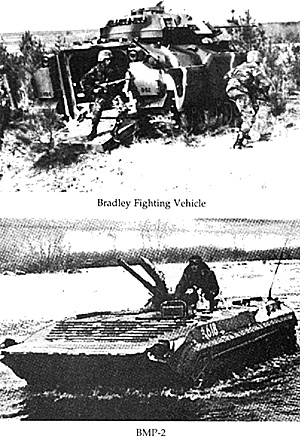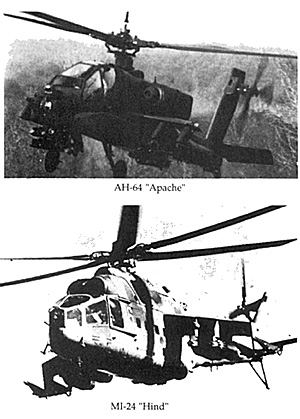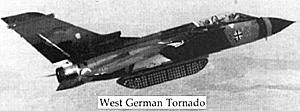 To consider the Soviet response to the question of
technology, an overview of Soviet thought on three laws of military
conflict must be considered.
To consider the Soviet response to the question of
technology, an overview of Soviet thought on three laws of military
conflict must be considered.
Bradley (top) and BMP-2 (bottom) infantry fighting vehicles.
In the 1977 edition of the Soviet Military Encyclopedia , six laws of military engagement were postulated, three of which are critical to this discussion. These are that the course and outcome of a war are a correlation of 1) the economic strength, 2) the scientific potential, and 3) the military forces of the warring nations. A cursory examination of these three laws shows they are closely interrelated with each other.
Reflect first on the third law, the military forces available to each side. Present estimates count 167 active and/or reinforceable divisions facing NATO in Western Europe. NATO forces can counter this threat with 88 active and mobilizable divisions. A recent Pentagon study of Soviet airpower states the Soviet Union has produced over 7,000 fighters since 1977 while the allied nations have built just over 3,100. Secretary of the Navy James Webb points out that the Soviet navy has significantly increased both its surface and submarine navy while NATO nations have failed to keep pace. Study after study expresses the same information: Soviet Bloc forces significantly outnumber the initial forces of NATO countries by a wide margin.
The "flexible response" philosophy argues that time must be made available by the initial contact forces so that reinforcement and rebuilding can be accomplished. In contrast, the underlying theme of Soviet conventional warfare is to be prepared in numbers far greater than your opponent can begin to realize or achieve. In the 1975 work, Soviet Military Strategy , V.D.Sokolovskiy noted that Soviet military theory stresses that the armed forces must be capable of winning a war at the outset. Although doctrine no longer dictates only standing forces will count in determining victory, such forces play a crucial role. This role is given greater impact when it is realized that Soviet doctrine does not accept the idea of a gradual buildup and time for extended mobilization.
Keeping the numerical superiority of the Soviet Bloc countries in mind, consider the question of economics as related to military policy. First and foremost, the Soviets view military spending as an adjunct of ideological policy making; thus, it is not subject to many of the political pressures frequently present in the West. Second, understand that the Soviet Union and its principal allies in the Warsaw Pact are a single geographical entity. Third, for the most part, ALL of the manufacturing needs and facilities are contained within the boundaries of this single entity; many are contained within the boundaries of the Soviet Union alone. Fourth, as a singular military structure, Soviet Bloc countries have a great deal of similarity in equipment, manufacturing procedures, and design features.
NATO, on the other hand, suffers from some serious disadvantages. A glance through any major news publication will point out the problems inherent in developing a cohesive approach to military spending in any single country, much less between the various nations of the NATO group. This difficulty in arranging adequate military funding is compounded by the large geographical splits that exist between member nations, particularly the United States and its European allies. these geographical differences, combined with national pride, have resulted in numerous equipment, manufacturing, and design differences between the various military forces of NATO. For example, American vehicles cannot use European fuel. In addition to these disadvantages, NATO countries suffer by contrast with the Soviet Bloc in terms of resource availability and survivability. The demands of superior technology for special materials in manufacturing are considerable. Despite policies of stockpiling, the NATO allies are still dependent on numerous foreign suppliers, and delivery is susceptible to interdiction.
The general response to many of the questions of superior numbers and to the questions of logistics is that superior technology will negate these disadvantages. Such an approach ignores the fact that technological superiority is not independent of either area of question, except in the rarest circumstances. The NATO alliance is not Italy attacking Ethiopia, or Great Britain fighting the Zulus, or the United States battling the American Indian. Critics of Soviet capability point with a certain degree of smugness to Belenko's comments about the MiG-25, to the ineffectiveness of the Arabs in the battles with Israel, and to the problems of the Soviet Union in Afghanistan. Even when faced with evidence of great strides by the Soviets in weapons technology, they respond by declaring that the United States and its allies will develop something better.
 AH-64 Apache (top) and MI-24 "Hind" (bottom) helicopters.
AH-64 Apache (top) and MI-24 "Hind" (bottom) helicopters.
The underlying assumption seems to be that Soviet leaders cannot recognize the value of technological advancement. And, even if they could, Soviet scientists are incapable of developing anything on their own. Nothing could be further from the truth. The question of scientific capability is not only one of the six laws of military engagement, but technology is one of the basic parameters to be examined in the study of war as a social phenomenon. The prime text of Soviet military philosophy, The Basic Principles of Operational Art and Tactics, edited by V. Ye. Savkin, stresses the importance place on developing and maintaining sufficient modern weaponry to ensure that the Soviet soldier takes the field with the best equipment possible. Concern with technology does not indicate, however, that the Soviet military is frightened by existent Western "superiority" in weaponry, nor does it indicate that the Soviets are so technologically deficient as to be incapable of meeting and defeating Western allies in the field.
Before examining the Soviet response to the technological problems, two factors that have greatly influenced their conventional warfare development must be noted. The first of these concerns the matter of priorities established by the Soviet military. Beginning in the early sixties and lasting a decade, much of the Soviet emphasis was on the development of an effective and defensible strategic missile delivery system. As stated previously, Soviet military doctrine argues that non-Socialist states are the aggressors and will, in all likelihood, attempt to launch a first strike against the Soviet Bloc. At the expense of conventional equipment development, the Soviet military expended vast resources to develop nuclear capabilities equal to or greater than the West's arsenal. Concurrent with this emphasis, the Soviets engaged in massive civil defense projects and internal defense systems in an attempt to counter the effects of any Western nuclear strike. Thus, a certain amount of lag time has existed in the development of high tech equipment for the conventional battlefield soldier.
The second factor relates directly to the availability of technological expertise. The lag time created by the emphasis on nuclear deployment left the Soviet Union without certain frames of reference for examining design parameters of conventional equipment. Utilization of computer systems, development of airframes and sensor systems, analysis of the needs of contemporary armored vehicles are but a few examples of the areas that suffered. Additionally, manufacturing techniques were also slow to develop as were training procedures. As the Soviets found they could concentrate less on nuclear weapons, they studied the experiences of their allies in local conflicts - North Vietnam, Libya, Syria. Attempts began to rectify the discrepancies between the technology of the Soviet Bloc and its Western opponents.
The primary reasoning behind supporting the Soviet assumption lies in the military programming of the Western Allies. Despite arguments that they hold an overwhelming technological edge in conventional weaponry, Western military planners make sure that everyone is aware that a nuclear weapons response is planned if the Soviet forces gain the advantage. It matters little whether the plan is called "massive retaliation", "trip wire" response, or "flexible response", if the outcome is the same: the threatened or actual use of nuclear weapons.
The secondary reasoning behind a support of the Soviet assumption lies in understanding how the Soviet Bloc has responded and will respond to the technological advantage of the West. First, the Soviet military theorists do not view technology as a singular entity. Instead they believe that technology is layered and categorized rather than an all encompassing factor. Second, Soviet analysts are prepared to suffer great casualties during certain phases of the conflict in order to gain an advantage in other areas which they believe will ultimately lead to victory. Finally, the Soviets believe they can forestall the use of certain Western technology by implementing particular military actions.
To fully understand the approach taken by Soviet analysts to the question of technology necessitates that certain Western prejudices be eliminated. Foremost among these is the presumption that technological advantage is concrete and unassailable. Many believe that the existence of Western superiority in general automatically translates into an overwhelming advantage in all areas and for an extended period of time. Unless an opponent can achieve a state of parity with the side holding the technological advantage, then victory for the opponent is impossible. Such a line of reasoning ignores the possibility that measures may be adopted which, although not as sophisticated as the target technology, can either destroy or severely damage the effectiveness of the technological advantage. Additionally, this line of thought ignores the possibility that an opponent will concentrate on developing only certain lines of technological expertise in the belief that those areas are the most critical. These two possibilities have not been ignored by Soviet military planners.
The Soviets do not presume to claim they can or will equal the West in the realm of technological achievement. They have analyzed the application of technology to the arena of combat and have determined that future wars will be fought at various levels of technological expertise. Although initially, many of these levels will be intermixed, they argue that the course of the war will progress steadily downward in terms of technological competency from a level of super technology to a state of low technology. The winner of any future conflict will be the combatant most adequately prepared to wage war on any and all levels.
The other prejudice that must be overcome is coincident with that of believing in the invincibility of technological advantage. Belief in the premise that "once dumb, always dumb" assumes the opponent is incapable of recognizing deficiencies and even if the lacks are evident, is incapable of countering the problem.
Soviet military policy makers have been aware of their deficiencies in certain areas of technical expertise and equipment. To eliminate and/or mitigate the effects of these deficiencies, the Soviets have undertaken every available option of approach to the acquisition of technical materials and equipment. In addition to the programs undertaken within the Soviet Bloc, where lessening focus on strategic weapons has allowed more concentration on conventional weapons development, the Soviets have developed a vast network of spies in the civilian and military populations of the Western Allies to procure data and materials. The recent exposure of the spy ring led by the Walkers is indicative of the quality of that network. Western analysts have been shaken by the amount of material transmitted into Soviet hands. If access to the material is difficult, actual theft of the materials has been known to occur.
 West German Tornado.
West German Tornado.
Whenever possible, the Soviets have employed treaty and diplomatic agreements to procure materials. Iran is known to have provided both sensor and missile technology from the F-14 Tomcats, left in the hand of Khomeini after the fall of the Shah. As has recently been exposed, the Soviets purchased outright from Western companies documents and manufacturing components. Such purchases have included items as seemingly mundane as video games to sophisticated computer data to highly sensitive military technology, as in the case of Toshiba Machine and Konigsberg Trade. Despite efforts by Western nations to close off sources and to continually upgrade their own technology, disclosures about Soviet acquisitions and the appearance of new military hardware demonstrate that much of this effort has been in vain.
When attention is turned to conventional warfare, then, caution must be exercised in examining the capabilities of the Soviet Bloc. Surface analysis may indicate they are lagging behind the United States and its allies, but a more thorough investigation reveals that the Soviets are confident that they have both the operational programs and the necessary equipment to successfully engage the West. Knowing their principal opponents will be the technologically- developed nations of the West, Soviet military analysts have prepared a careful and detailed policy of engagement.
Soviet preparations for any confrontation, nuclear or conventional, are premised upon certain considerations. First is that the focus of any conflict will be upon winning the war, not winning a particular battle or series of battles. Expectations exist among the Soviets that certain facets of the conflict will either be lost and/or they will suffer considerable casualties. Along with this premise is the consideration that warfare is extraordinarily resource-intensive. With overtones of the classic statement about "a war of attrition", the Soviets see warfare as a process of wearing away the enemy by gobbling up large numbers of men and equipment. The third consideration is virtually a summation of the first two: Soviet military policy rests on the belief that the "whole is greater than the sum of its parts." When all other factors are equal (or nearly so), then quantity will win over quality. In this manner, little attention need be paid to individual occurrences or to individual failings; such are considered aberrations and not indicative of the battle as a whole.
By developing operational programs based on these considerations, the Soviet military structures an approach believed viable against the seemingly superior technological forces of the West. Critically, programs based on such considerations immediately serve to negate one cornerstone of the arguments given that Western technology will halt a Soviet invasion. Technological status need no longer be a question of equal or better. The Soviets need only possess equipment capable of meeting Western force in sufficient numbers to overcome any possible Western advantage. This idea of viable, not necessarily comparable, technology is important to keep in mind.
When taken in concert with Soviet operational doctrine, advances in technological strength (developed, bought, or stolen), as well as the equipment production capability of the Soviet Bloc, tip the scales in favor of the Soviets and their allies in a conventional war. To analyze the application of these factors, the operational program of the Soviet Bloc must be contrasted to the expected preparations and responses of the West. To attempt to analyze the effectiveness of Soviet military development in any other fashion is to work in a vacuum. Western theorists have openly expressed the methodology to be employed against a Soviet invasion and, thus, provide an excellent basis for examining Soviet operational art. The focus of the examination will be to consider the Soviet actions against the West's battle doctrine.
More Soviet Conventional Combat Philosophy by Owen Stanley
- Introduction
Soviet Military Thought
Laws of Military Conflict
Soviet Planning
Opening Assault
Conclusion
Back to Table of Contents: CounterAttack #1
To CounterAttack List of Issues
To MagWeb Master Magazine List
© Copyright 1987 by Pacific Rim Publishing Company.
This article appears in MagWeb (Magazine Web) on the Internet World Wide Web.
Other military history articles and gaming articles are available at http://www.magweb.com